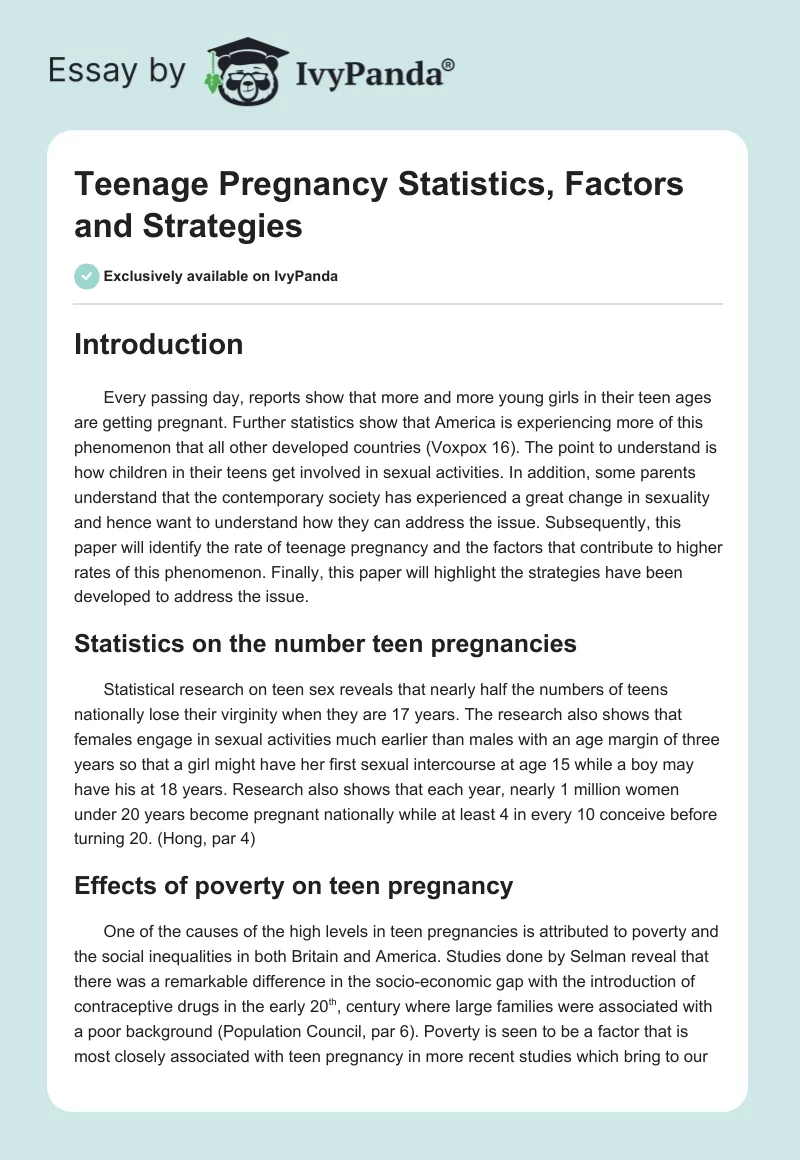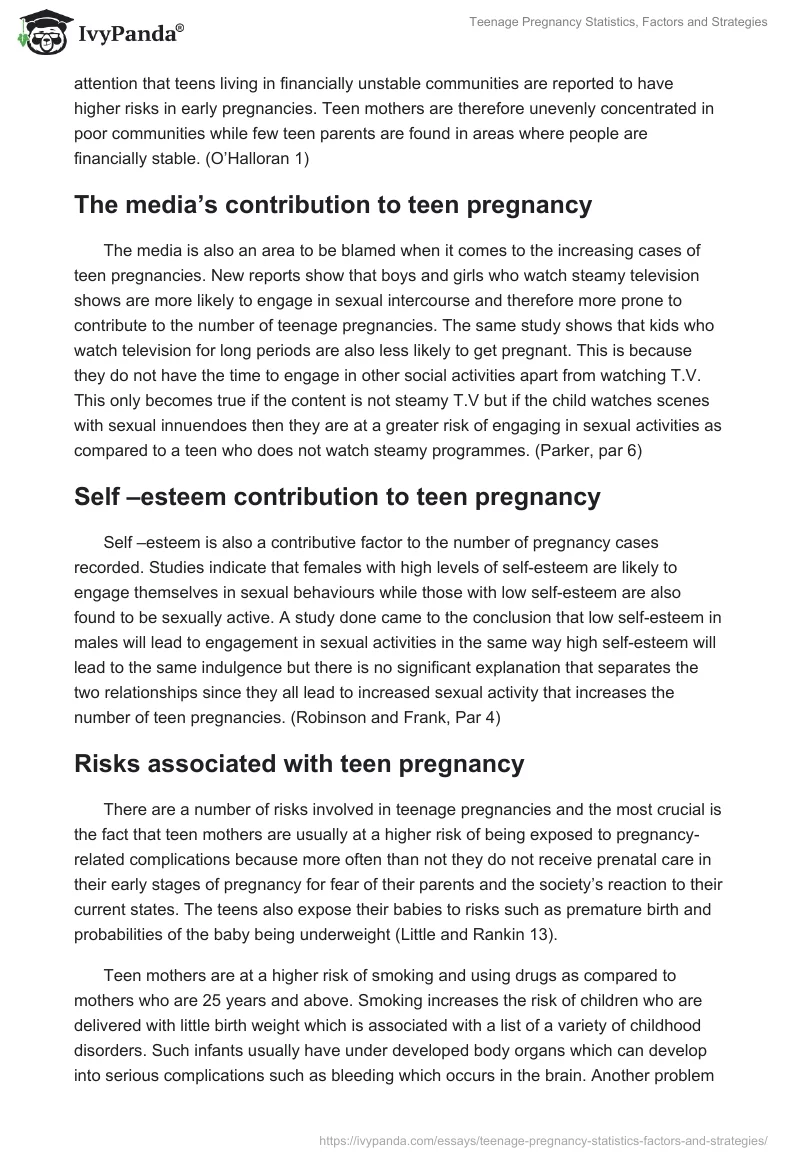Introduction
Every passing day, reports show that more and more young girls in their teen ages are getting pregnant. Further statistics show that America is experiencing more of this phenomenon that all other developed countries (Voxpox 16). The point to understand is how children in their teens get involved in sexual activities. In addition, some parents understand that the contemporary society has experienced a great change in sexuality and hence want to understand how they can address the issue. Subsequently, this paper will identify the rate of teenage pregnancy and the factors that contribute to higher rates of this phenomenon. Finally, this paper will highlight the strategies have been developed to address the issue.
Statistics on the number teen pregnancies
Statistical research on teen sex reveals that nearly half the numbers of teens nationally lose their virginity when they are 17 years. The research also shows that females engage in sexual activities much earlier than males with an age margin of three years so that a girl might have her first sexual intercourse at age 15 while a boy may have his at 18 years. Research also shows that each year, nearly 1 million women under 20 years become pregnant nationally while at least 4 in every 10 conceive before turning 20. (Hong, par 4)
Effects of poverty on teen pregnancy
One of the causes of the high levels in teen pregnancies is attributed to poverty and the social inequalities in both Britain and America. Studies done by Selman reveal that there was a remarkable difference in the socio-economic gap with the introduction of contraceptive drugs in the early 20th, century where large families were associated with a poor background (Population Council, par 6). Poverty is seen to be a factor that is most closely associated with teen pregnancy in more recent studies which bring to our attention that teens living in financially unstable communities are reported to have higher risks in early pregnancies. Teen mothers are therefore unevenly concentrated in poor communities while few teen parents are found in areas where people are financially stable. (O’Halloran 1)
The media’s contribution to teen pregnancy
The media is also an area to be blamed when it comes to the increasing cases of teen pregnancies. New reports show that boys and girls who watch steamy television shows are more likely to engage in sexual intercourse and therefore more prone to contribute to the number of teenage pregnancies. The same study shows that kids who watch television for long periods are also less likely to get pregnant. This is because they do not have the time to engage in other social activities apart from watching T.V. This only becomes true if the content is not steamy T.V but if the child watches scenes with sexual innuendoes then they are at a greater risk of engaging in sexual activities as compared to a teen who does not watch steamy programmes. (Parker, par 6)
Self –esteem contribution to teen pregnancy
Self –esteem is also a contributive factor to the number of pregnancy cases recorded. Studies indicate that females with high levels of self-esteem are likely to engage themselves in sexual behaviours while those with low self-esteem are also found to be sexually active. A study done came to the conclusion that low self-esteem in males will lead to engagement in sexual activities in the same way high self-esteem will lead to the same indulgence but there is no significant explanation that separates the two relationships since they all lead to increased sexual activity that increases the number of teen pregnancies. (Robinson and Frank, Par 4)
Risks associated with teen pregnancy
There are a number of risks involved in teenage pregnancies and the most crucial is the fact that teen mothers are usually at a higher risk of being exposed to pregnancy-related complications because more often than not they do not receive prenatal care in their early stages of pregnancy for fear of their parents and the society’s reaction to their current states. The teens also expose their babies to risks such as premature birth and probabilities of the baby being underweight (Little and Rankin 13).
Teen mothers are at a higher risk of smoking and using drugs as compared to mothers who are 25 years and above. Smoking increases the risk of children who are delivered with little birth weight which is associated with a list of a variety of childhood disorders. Such infants usually have under developed body organs which can develop into serious complications such as bleeding which occurs in the brain. Another problem associated with smoking is the likely hood of the teen mother to give birth to a still born baby (Banarjee et al 4).
Consequences of teen pregnancy
There are varied consequences involved with teen pregnancy. Teen mothers are likely to discontinue with their educations and most end their educations at high school level which will result to them depending on welfare, which has the effect of increasing the number of unemployed individuals in the state and increasing the dependency ratio per capita. Since these parents will lack financially their children will be at a higher risk of joining gangs thus contributing another negative factor in the society (Saunders 67; Contemporary Sexuality 5).
Education programmes as a preventive measure against teen pregnancy
Conducting an education program on sex with the aim of educating youths when they are still young about the changes that are yet to occur in their bodies prepares them psychologically and prevents them from having prudish behaviours which is one of the reasons why girls get pregnant during sexual intercourse at early ages. The sex also exposes them to sexually transmitted diseases such as HIV/AIDS but with the programmes aimed at educating youths, these will be prevented as they will be advised on preventive measures such as the use of condoms which prevents STI’s and contraceptives which prevent unwanted pregnancies (Corle, par 3).
Campaigns as a method of preventing teen pregnancy
An aggressive campaign aimed at enlightening youths against premature sex at tender ages has been started and is supported by public figures such as Barack Obama. In support of the campaign, every first Wednesday in May since 2002 has been set aside to celebrate the National Day to Prevent Teen Pregnancy. Special agencies have also been set aside such as the US organisation called Stay Teen which aims at campaigning thoroughly against teen pregnancies. Through such projects, and the effort shown by the media and literature writers through books and movies to support the campaign, it has become the sincere hope of many that these efforts do not go to waste (Christenson and Rosen, Par 20; Suner et al 73).
Conclusion
In conclusion of the findings, the study reveals that the highest percentages of teen pregnancies are reported in the United States as compared to other European countries. Statistics also point out that most adolescents loose virginity even before reaching 17 years and a comparison between boys and girls sexual activities shows that females engage in sex earlier than males by a margin of 3 years. Poverty also is seen to contribute to teen pregnancy while low or high self-esteem is seen to bring the same effect which is a rise in the number of premature sex (Population Council, par. 4). Teen parents are at greater risks of giving birth to premature babies and smoking cigarettes and other consequences such as dropping out of school. Campaigns are also being undertaken in the hope of reducing the percentage of youths involved in teen pregnancies. The research done by several articles including this one does not seek to scare the youths as it may appear, but it wants to bring to light the dangerous effects brought about by youth’s engagement in premature sex.
Works Cited
Banarjee, Bratati., Dutt, Debashis, Sengupta, Bhaswati., Mondal, Maitraeyi and Deb, Sila. Teenage Pregnancy: A socially inflicted Health Harzard. Department of Community Medicine, Maulana Azad Medical College. New Delhi, India.
Christensen, Sue and Rosen, Ann. Teenage pregnancy. 1996. Web.
Contemporary Sexuality. American Association of Sexuality Educators, Counsellors and Therapists. 2009; 43(7): 3-6.
Corle, Sharon. State Inovations to Prevent Teen Pregnancy. 2006. Web.
Hong, Zhang. Teen Pregnancy Information And Facts. 2007. Web.
Little, Craig and Rankin, Andrea. Why do They Start it? Explaining Reported Early -Teen Sexuality Activity O’Halloran, Peggy. Pregnancy, Poverty, school, employment. 1998. Web.
Parker, Tara. Behind the Statistics on TV and Teen Pregnancy. 2008. Web.
Population Council. Unexplored Elements of Adolescence in the Developing World.
Population Briefs, 2006, 12(1): 34- 42. Web.
Robinson, Rachel. Frank, Deborah. The Relationship between Self- Esteem, Sexual Activity and Pregnancy. 1994. Web.
Saunders, Jeanne. Adolescent Pregnancy Prevention Programs: Theoretical Models for Effective Program Development. American Journal of Sexuality Education. 2005; 1(1): 63- 84.
Suner, Janet., Nakamura, Sharon., and Caulfield, Rick. Kids Having Kids: Models of Intervention. Early Childhood Education Journal. 2003; 31(1): 71- 74.
VoxPox. Will More Young Women Become Pregnant for Fame? Children & Young People now. 2009: 16-17.


